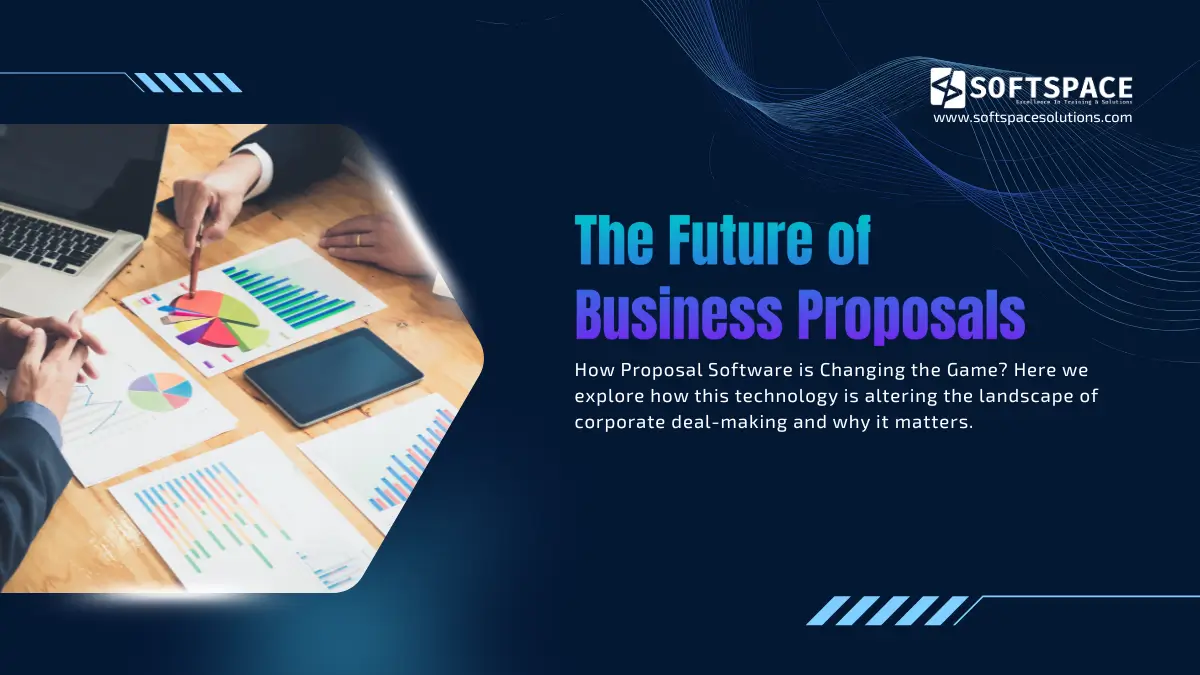Business proposals are becoming active digital assets in today’s market. In this piece, we discuss what is the future of business proposals and how this technology is transforming the way firms negotiate and why it is important for enterprises of all sizes. Learn how to make the most of the newest proposal management technologies by reading on.
Table of Contents
What is the future of business proposals and the rise of proposal software?

Writing business proposals the old-fashioned manner, which involved assembling documents by hand and took a long time to deliver to the client, was frequently a hassle. The degree of knowledge and effort put out by the person proposing the proposal greatly influenced its accuracy, which resulted in errors and inconsistencies. In this regard, the creation of proposal software has altered how companies carry out this crucial task, providing them with a more effective and reliable way to write proposals.
These days, companies can use technology to create proposals with more strategic information and a better appearance. Modifying proposals to directly meet the requirements and concerns of the potential client is simple with today’s tools. Because proposal software creates a defined procedure that all team members can follow, it is crucial for effective resource management.
Tools like proposal software allow businesses to process more proposals without sacrificing quality. Platforms like Qvidian offer templates and content libraries that ensure your brand remains consistent while saving you time.
The future of business proposals is much more dynamic and adaptable because these tools can be modified and accessed from any location in the world, thanks to real-time updates and cloud-based technologies.
Streamlining Proposal Creation: The Efficiency of Automation
One significant shift in how businesses manage their bidding procedures is the use of automation in proposal creation. Instead of repeatedly performing the same duties, teams may concentrate on strategy and personalisation.
Typical features of proposal software include auto-fill for common data, which ensures accuracy and frees up resources for the more crucial, personalised portions of a proposal.
The likelihood of delays in the proposal process can be significantly reduced by automating some procedures. It guides users through a pre-established set of processes, ensuring that all required components are present and verified via the appropriate channels.
Collaboration is made simple by alerting team members when their opinions or reviews are required.
These systems improve and elevate the end product’s appearance. No more rushing to obtain information or approvals at the last minute. Proposal development, on the other hand, follows a steady, structured rhythm that enhances the company’s image and increases the likelihood that bids will be accepted.
Enhancing Collaboration: Proposal Software as a Team Tool

Proposals’ evolution and the emergence of proposal software
As you noted, the emergence of specialised proposal/bid management software has changed how businesses carry out this important function.
Important changes include:
- Businesses switched from manually putting together documents to using software-enabled templates and content libraries.
- From static to dynamic: Proposals are now web-accessible, trackable, versioned, and live rather than as one-time attachments.
- From regional to worldwide/cooperative Cloud-based tools allow teams from different locations to collaborate and react instantly.
- From one-time usage to reusable assets: Content (such as pricing tables and case studies) becomes modular, allowing for multiple reuses after initial approval.
- From output to insight, contemporary platforms offer data that show which suggestions are successful, which areas receive the most clicks, and where bottlenecks are found.
Important statistics to note:
- By 2030, the global proposal management software market is expected to have grown from its 2022 valuation of approximately USD 2.33 billion to approximately USD 5.81 billion.
- According to one forecast, the market would increase at a CAGR of around 11.4% between 2024 and 2029, reaching USD 4.32 billion in that year.
- A subset/adjacent market, the RFP (Request for Proposal) software market, was estimated to be worth USD 2.28 billion in 2023 and is expected to grow to USD 7.38 billion by 2031.
These numbers demonstrate that businesses of various sizes and in all regions are investing, proving that this is not a specialised tool.
Simplifying the creation of proposals: The effectiveness of automation
In order to transform cost-centred proposals into scalable digital assets, automation is essential.
The benefits of automation:
- Errors and duplication are decreased by auto-filling common data (customer name, address, contact information, and standard terms).
- The correct order is guaranteed via guided workflows (e.g., draft → marketing review → legal review → pricing approval → mailing). Delays are decreased as a result.
- Approved text blocks, case studies, and pricing tables are examples of content libraries that expedite creation while upholding compliance and brand.
- Consistency between proposals is ensured by template-driven layouts, which improve professional appearance and brand image.
- With cloud access, team members may work from anywhere, which is particularly useful in the era of remote and hybrid working.
Advantages for businesses:
- Quicker turnaround: successful bids depend on quickness. A business that can react more quickly frequently obtains a competitive advantage.
- Savings: lower internal costs result from fewer hours needed for each proposal.
- Fewer mistakes: more precision lowers risk (e.g., of misquoted pricing or out-of-date contract terms) and increases credibility.
- Increased volume: Teams can generate more proposals without experiencing linear increases in effort by reducing the marginal cost of each proposal.
Example pointer: An automated workflow that notifies several stakeholders (sales, finance, and legal) when a step is pending lowers the possibility that someone is unaware of the delay.
When working on proposals, it’s frequently required to get input from many departments, which can be challenging without the proper tools. People from a variety of industries, including finance, marketing, sales, and more, can collaborate and exchange knowledge using proposal software. In addition to improving the proposal, this synergy makes the organisation seem more cohesive.
Multiple team members can collaborate on a proposal at the same time without fear of erasing one another’s work thanks to real-time editing. Because it can react to criticism and fresh concepts as they arise, this increases the process’s adaptability and creativity. This is particularly useful when time is limited. Communication tools are frequently included in proposal software, which helps to maintain all discussion threads connected to the document.
Proposal software uses permission settings and access controls to protect sensitive data. Project managers have control over what is seen, when it is seen, and what can be done about it. This maintains the confidentiality and integrity of the proposal process. This degree of supervision involves monitoring modifications and recommendations, which clarifies the workflow and leaves it available for auditing and review as needed.
Tailored Analytics and Reporting: Making Informed Decisions
The analytics and reporting capabilities of proposal software are not limited to displaying win-loss statistics. They provide extensive information on how proposals operate, client engagement, which portions are most frequently used, and how well documents function. Making adjustments to the content and layout of upcoming bids can be greatly aided by this information.
Companies can generate data-based proposals by using the software’s reports to analyse how well various strategies perform. Teams can utilise it to learn what prospective customers like and dislike, which will help them craft more compelling and pertinent proposals. A thorough grasp of organisational performance can also be improved by incorporating these insights into larger business intelligence platforms.
In addition to quantitative analytics, proposal platforms can assist you in obtaining qualitative client feedback. By connecting to third-party tools or using built-in survey features, these platforms enable you to continuously obtain feedback. As proposals are refined to better suit clients’ requirements and expectations, this may eventually result in increased conversion rates.
In addition to altering the process of making proposals, the usage of proposal software in business has completely transformed how companies expand. Businesses that wish to succeed in an increasingly competitive market are finding that these cutting-edge instruments are indispensable. They are effective, safe, and compliant.
Using Proposal Software as a Team Tool to Improve Collaboration
Sales, finance, marketing, operations, and legal are just a few of the departments that frequently need to contribute to proposals. Without the appropriate tool, this coordination can be difficult. Proposal software acts as a central hub, enabling seamless teamwork, improving accountability, and ensuring every proposal aligns with business goals and brand identity.
Key Collaboration Features to Highlight
- Real-Time Editing – Allows several team members to work on the same document simultaneously without version conflicts.
- Inline Comments and Annotations – Enables team members to provide contextual feedback directly within the proposal, keeping discussions relevant and avoiding scattered email threads.
- Role-Based Permissions – Let administrators control who can view, edit, approve, or update sections of the proposal, maintaining audit trails, governance, and security.
- Integrated Communication Tools – Built-in chat or notification features alert reviewers automatically when their input is required, keeping the workflow on track.
Why Businesses of All Sizes Should Care
- For Large Enterprises – Facilitates complex, multi-stakeholder reviews, ensures message consistency across divisions, and reduces departmental silos.
- For SMEs and Mid-Sized Businesses – Provides a professional collaborative platform that enables smaller teams to respond quickly and competitively to large clients.
- For Distributed Teams – Cloud-based collaboration supports geographically separated teams. For example, marketing in Singapore, legal in the UK, and sales in India, ensuring smooth communication and unified proposal management.
Customised Reporting and Analytics: Making Wise Choices
Treating proposals as digital assets opens the door to rich insights and continuous improvement. Analytics help teams measure performance, identify bottlenecks, and make informed strategic decisions.
Common Metrics to Monitor
- Win Ratio – Number of successful proposals compared to total proposals sent.
- Time-to-Send – Time taken from opportunity creation to proposal delivery.
- Section-Level Engagement – Identifies which parts of web-viewable proposals clients engage with the most.
- Process Bottlenecks – Tracks where delays frequently occur within the review or approval workflow.
- Reuse Rate – Measures which content blocks are used most or least to identify what needs updating or removal.
- Client Interactions and Feedback – Monitors client activity and responses for valuable qualitative insights.
Importance of Proposal Analytics
- Identify Weak Points – Detect where proposals underperform (for example, in specific industries or client segments).
- Enable Data-Driven Refinement – Discover what content or case studies increase engagement and which reduce responsiveness.
- Improve Forecasting Accuracy – Estimate revenue more reliably using metrics like win rate and average deal value.
- Promote Accountability – Measure team responsiveness, number of revisions, and turnaround times to ensure efficiency.
Statistic Insight: The growth of cloud-based solutions and remote collaboration is a key driver of the global proposal software market’s expansion.
Why Businesses of All Sizes Should Be Concerned
- Professionalism and Brand Consistency – Well-written, punctual, and consistent proposals convey reliability and competence.
- Scalability – As your company grows, systems allow you to scale proposal production efficiently, unlike manual methods.
- Competitive Advantage – Responding faster, more accurately, and with personalised proposals strengthens your edge in bidding.
- Cost Control – Reducing hours spent on manual proposal creation saves time and resources across departments.
- Data-Driven Decision-Making – Historical proposal data helps refine strategies, improve win rates, and target the right markets.
- Improved Collaboration and Remote Readiness – Modern tools support hybrid teams, ensuring seamless collaboration.
- Risk Management and Compliance – Ensures proposals follow approved terminology, accurate pricing, and compliance standards — critical in regulated sectors like finance, healthcare, and defence.
How to Maximise the Use of the Latest Proposal Management Technologies
1. Define Your Process Before Implementing Tools
- Map your existing workflow — who drafts, reviews, and approves.
- Identify pain points such as delays between departments.
- Determine what should be standardised (branding, templates) and what needs customisation (client narrative, pricing).
2. Build a Modular Content Library
- Create approved text blocks (case studies, service descriptions, company summaries, testimonials, standard terms).
- Tag each block by industry, use-case, and client size for quick retrieval.
- Maintain version control to update content universally when changes occur.
3. Select and Configure the Right Software
- Prioritise cloud-based solutions for accessibility and version control.
- Ensure it includes templates, workflows, content libraries, collaboration tools, and analytics.
- Look for integrations with CRM, e-signature, ERP, and marketing automation tools.
- Set access controls to protect sensitive content and restrict authorisation.
- Conduct user training to ensure adoption and efficiency across departments.
4. Establish Metrics and Continuous Improvement
- Track key KPIs such as proposals sent, won, time-to-send, average deal value, and engagement data.
- Use analytics to ask critical questions: Which templates convert best? Which industries perform poorly and why?
- Conduct regular reviews to refresh the content library, update templates, and remove outdated material.
5. Align Content with Client Context
- Personalise the narrative for each client using real data, KPIs, and strategic objectives.
- Replace generic messaging with tailored solutions that resonate with client challenges.
- Update terms, pricing, and conditions to reflect each specific opportunity.
6. Ensure Brand Consistency and Compliance
- Use standardised templates for logos, fonts, and colours.
- Include approved legal and financial content to avoid outdated information.
- Maintain audit trails showing who edited and approved changes for regulatory accountability.
7. Use Analytics to Inform Future Proposals
- Analyse proposal performance data to refine pricing models and templates.
- Highlight high-performing case studies for future use.
- Investigate underperforming sectors or clients and adjust strategies accordingly.
Final Thought
By leveraging proposal software as a collaborative and analytical tool, businesses can transform a once-manual process into a scalable, data-driven, and highly efficient operation. Whether you’re a global enterprise or a growing SME, modern proposal management tools enable faster turnaround, better team synergy, consistent branding, and smarter decisions, turning every proposal into a powerful digital asset.

13+ Yrs Experienced Career Counsellor & Skill Development Trainer | Educator | Digital & Content Strategist. Helping freshers and graduates make sound career choices through practical consultation. Guest faculty and Digital Marketing trainer working on building a skill development brand in Softspace Solutions. A passionate writer in core technical topics related to career growth.

